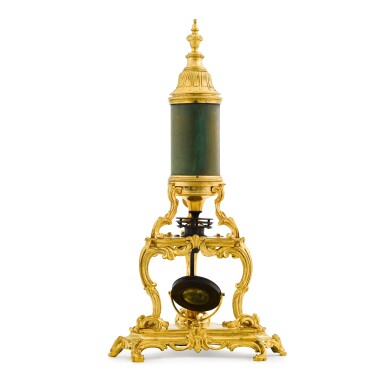
A Louis XV microscope, attributed to Claude-Siméon Passemant, the gilt-bronze probably by Jacques & Philippe Caffieri, Paris, circa 1745-1750
Auction Closed
October 11, 05:25 PM GMT
Estimate
350,000 - 500,000 EUR
Lot Details
Description
A Louis XV microscope, attributed to Claude-Siméon Passemant, the gilt-bronze probably by Jacques & Philippe Caffieri, Paris, circa 1745-1750
gilt-bronze, shagreen, glass; the tripod base decorated with rocaille clasps supporting three S-shaped legs and a platform equipped with a mirror to control the illumination, the stage of the instrument fixed with a lens holder, the cylindrical body of the microscope covered with a blue-green shagreen, supported by a vertical bar of rectangular section attached to the pedestal and the lower half with a pinion, surmounted by a dome decorated with leaves and a finial which can be unscrewed to access the eyepiece in order to look at a specimen under magnification
height lowest position 20⅞in.; height highest position 22¾in.; width 10⅝in.; 53 cm; 58 cm; 27 cm.
____________________________________________
Microscope en galuchat, verre et bronze doré, attribué à Claude Siméon Passemant, le bronze doré probablement par Jacques et Philippe Caffieri, Paris, d'époque Louis XV vers 1745-1750
height lowest position 20⅞in.; height highest position 22¾in.; width 10⅝in.; 53 cm; 58 cm; 27 cm.
This microscope of a remarkably well-balanced design represents one of the rare illustrations combining the important technical and scientific innovations and the refinement in gilded bronze work of the mid-18th century, requiring the intervention of the most highly-skilled craftsmen of the time such as Claude-Siméon Passemant and the Caffieris. A further study of this important object will reveal the context in which it was made, when the scientific curiosity of the 18th century developed a relationship with art - the exciting meeting of science and luxury.
A synthesis of art and science
This microscope is part of a real phenomenon from around 1740 in France that saw the multiplication of scientific collections and laboratories, which coincided with the expansion of the Louis XV style. A worldly physicist whose experimental genius was recognized by the whole of Europe, Jean-Antoine Nollet championed the teaching of science in France and in fact, in 1758, he was named Maître de Physique des Enfants de France, and taught, for example, the future kings Louis XVI, Louis XVIII, and Charles X. On the frontispiece of Nollet's Leçons de physique experimentale, vol. 1 (Paris, 1743-1764), Abbé Nollet is seen teaching experimental physics (fig.1). Of note is the methodical arrangement of the collections of instruments in the background, enriched by the presence of a wall regulator clock by Charles Cressent. This engraving highlights how scientific instruments entered art collections with ease as works of art in their own right.
This type of microscope was probably made for the first time for the King at the Pavillon d'Optique housed in Château de la Muette, where the first collection of Louis XV was held from 1756 and supervised between 1759 and 1775 by Dom Noël. Dom Noël’s series of plates engraved representing the scientific instruments in the royal collection of the Château de la Muette, include four plates devoted to a microscope almost identical to this one (fig.2).
Whilst Charles Claude Flahaut, Comte de la Billarderie d'Angiviller seems to have written in his Mémoires that Dom Noël sold a large number of telescopes and microscopes at high prices, only a small number of these tripod microscopes, derived from the Culpeper model, are known today:
- One, signed by Passemant, is in the Metropolitan Museum of Art (MET), New York (1986.1a-d), donated by Mr and Mrs Charles Wrightsman (fig.3)
- A second was part of the Pierre Marly collection in Paris.
- Another is illustrated in the sale catalogue of the collection of Jacques Doucet, 7-8 June 1912, lot 255, subsequently with the Kugel gallery in 1975 (according to J-N Ronfort, "Science and Luxury : two acquisitions by The J. Paul Getty Museum", The J. Paul Getty Museum Journal, volume 17, 1989, p.78)
- Another was recently presented by the Kugel Gallery at TEFAF, Maastricht, 2020.
-one formerly in the collection of Jacques Seligmann, sold recently at Christie’s, London, The Exceptional Sale, 23 November 2021, lot 208 (1,016,000 EUR)
You May Also Like










